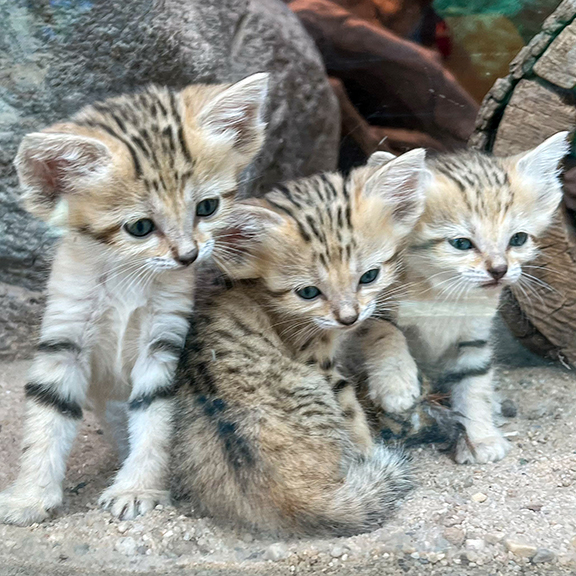Welcome!

NC Zoo
The votes are in
ASHEBORO — Online voters have chosen: The name of the three sand cat kittens at the North Carolina Zoo are Amira, Cleo and Jabari.
More than 15,000 voters took part, picking from a list of names provided by zookeepers.
Two girls and a boy were born on May 11. From the winning names:
— Amira is an Arabic name meaning “princess.”
— Cleo is short for Cleopatra, a famous queen of Egypt.
— Jabari is an Arabic name meaning “brave/fearless.”
The kittens were born to first-time mother Sahara, 3, and father Cosmo, 9. This is the first litter for the sand cat pair. Cosmo previously fathered daughter Layla, now living at the Greensboro Science Center.
Cosmo and Sahara were paired as a part of the Association of Zoos and Aquariums (AZA) Sand Cat Species Survival Plan, which aims to maintain a healthy and genetically diverse population of sand cats to increase their numbers. More than 50 sand cats live at over 20 AZA institutions.
Desert Keeper Eric Mahan said, "Glad to see herding cats is just as difficult for cats as it is the rest of us, and yet first-time mom Sahara is doing a fantastic job with her very fast, very adventurous, and sometimes very naughty three kittens."
Though they appear adorable with big ears, eyes, and petite frame, looks can be deceiving. Zookeepers are quick to tell you sand cats are wild, ferocious animals that should never be kept as pets. These small and mighty hunters kill venomous snakes in the desert. They are the only cats to live exclusively in desert environments.
Sand cats are native to the deserts of North Africa, the Arabian Peninsula and Asia. Nocturnal in nature, they quickly adapt to the extreme climate of desert environments with very hot and cold temperatures.
Sand cats are rarely sighted in the wild because they live in remote landscapes, hunt at night to avoid the desert heat, and are secretive in nature, which makes it challenging to study them. The size of the population and lifespan in the wild is unknown.
The sand cat is one of the world's smallest feline species, weighing from four to eight pounds and measuring, on average, 20 inches long. The gestation period is around 60 days. Under human care, a sand cat can live to be 13 years old.
The cats have an exceptionally keen sense of hearing, which they use to detect animals under the sand and use their excellent digging skills to capture their prey quickly.
